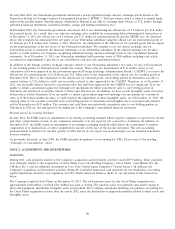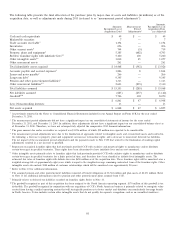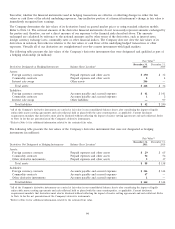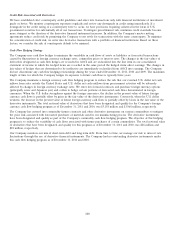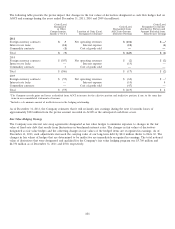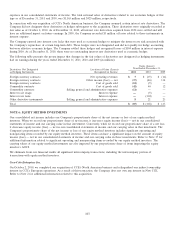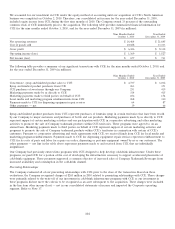Coca Cola 2011 Annual Report Download - page 102
Download and view the complete annual report
Please find page 102 of the 2011 Coca Cola annual report below. You can navigate through the pages in the report by either clicking on the pages listed below, or by using the keyword search tool below to find specific information within the annual report.Credit Risk Associated with Derivatives
We have established strict counterparty credit guidelines and enter into transactions only with financial institutions of investment
grade or better. We monitor counterparty exposures regularly and review any downgrade in credit rating immediately. If a
downgrade in the credit rating of a counterparty were to occur, we have provisions requiring collateral in the form of U.S.
government securities for substantially all of our transactions. To mitigate presettlement risk, minimum credit standards become
more stringent as the duration of the derivative financial instrument increases. In addition, the Company’s master netting
agreements reduce credit risk by permitting the Company to net settle for transactions with the same counterparty. To minimize
the concentration of credit risk, we enter into derivative transactions with a portfolio of financial institutions. Based on these
factors, we consider the risk of counterparty default to be minimal.
Cash Flow Hedging Strategy
The Company uses cash flow hedges to minimize the variability in cash flows of assets or liabilities or forecasted transactions
caused by fluctuations in foreign currency exchange rates, commodity prices or interest rates. The changes in the fair values of
derivatives designated as cash flow hedges are recorded in AOCI and are reclassified into the line item in our consolidated
statement of income in which the hedged items are recorded in the same period the hedged items affect earnings. The changes in
fair values of hedges that are determined to be ineffective are immediately reclassified from AOCI into earnings. The Company
did not discontinue any cash flow hedging relationships during the years ended December 31, 2011, 2010 and 2009. The maximum
length of time for which the Company hedges its exposure to future cash flows is typically three years.
The Company maintains a foreign currency cash flow hedging program to reduce the risk that our eventual U.S. dollar net cash
inflows from sales outside the United States and U.S. dollar net cash outflows from procurement activities will be adversely
affected by changes in foreign currency exchange rates. We enter into forward contracts and purchase foreign currency options
(principally euros and Japanese yen) and collars to hedge certain portions of forecasted cash flows denominated in foreign
currencies. When the U.S. dollar strengthens against the foreign currencies, the decline in the present value of future foreign
currency cash flows is partially offset by gains in the fair value of the derivative instruments. Conversely, when the U.S. dollar
weakens, the increase in the present value of future foreign currency cash flows is partially offset by losses in the fair value of the
derivative instruments. The total notional value of derivatives that have been designated and qualify for the Company’s foreign
currency cash flow hedging program as of December 31, 2011 and 2010, was $5,158 million and $3,968 million, respectively.
The Company has entered into commodity futures contracts and other derivative instruments on various commodities to mitigate
the price risk associated with forecasted purchases of materials used in our manufacturing process. The derivative instruments
have been designated and qualify as part of the Company’s commodity cash flow hedging program. The objective of this hedging
program is to reduce the variability of cash flows associated with future purchases of certain commodities. The total notional value
of derivatives that have been designated and qualify for this program as of December 31, 2011 and 2010, was $26 million and
$28 million, respectively.
Our Company monitors our mix of short-term debt and long-term debt. From time to time, we manage our risk to interest rate
fluctuations through the use of derivative financial instruments. The Company had no outstanding derivative instruments under
this cash flow hedging program as of December 31, 2011 and 2010.
100


